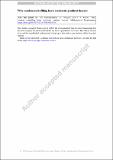| dc.contributor.author | Gürbüzbalaban, M. | |
| dc.contributor.author | Ozdaglar, A. | |
| dc.contributor.author | Parrilo, P. A | |
| dc.date.accessioned | 2021-09-20T17:41:33Z | |
| dc.date.available | 2021-09-20T17:41:33Z | |
| dc.date.issued | 2019-10-29 | |
| dc.identifier.uri | https://hdl.handle.net/1721.1/132030 | |
| dc.description.abstract | Abstract
We analyze the convergence rate of the random reshuffling (RR) method, which is a randomized first-order incremental algorithm for minimizing a finite sum of convex component functions. RR proceeds in cycles, picking a uniformly random order (permutation) and processing the component functions one at a time according to this order, i.e., at each cycle, each component function is sampled without replacement from the collection. Though RR has been numerically observed to outperform its with-replacement counterpart stochastic gradient descent (SGD), characterization of its convergence rate has been a long standing open question. In this paper, we answer this question by providing various convergence rate results for RR and variants when the sum function is strongly convex. We first focus on quadratic component functions and show that the expected distance of the iterates generated by RR with stepsize
$$\alpha _k=\varTheta (1/k^s)$$
α
k
=
Θ
(
1
/
k
s
)
for
$$s\in (0,1]$$
s
∈
(
0
,
1
]
converges to zero at rate
$$\mathcal{O}(1/k^s)$$
O
(
1
/
k
s
)
(with
$$s=1$$
s
=
1
requiring adjusting the stepsize to the strong convexity constant). Our main result shows that when the component functions are quadratics or smooth (with a Lipschitz assumption on the Hessian matrices), RR with iterate averaging and a diminishing stepsize
$$\alpha _k=\varTheta (1/k^s)$$
α
k
=
Θ
(
1
/
k
s
)
for
$$s\in (1/2,1)$$
s
∈
(
1
/
2
,
1
)
converges at rate
$$\varTheta (1/k^{2s})$$
Θ
(
1
/
k
2
s
)
with probability one in the suboptimality of the objective value, thus improving upon the
$$\varOmega (1/k)$$
Ω
(
1
/
k
)
rate of SGD. Our analysis draws on the theory of Polyak–Ruppert averaging and relies on decoupling the dependent cycle gradient error into an independent term over cycles and another term dominated by
$$\alpha _k^2$$
α
k
2
. This allows us to apply law of large numbers to an appropriately weighted version of the cycle gradient errors, where the weights depend on the stepsize. We also provide high probability convergence rate estimates that shows decay rate of different terms and allows us to propose a modification of RR with convergence rate
$$\mathcal{O}(\frac{1}{k^2})$$
O
(
1
k
2
)
. | en_US |
| dc.publisher | Springer Berlin Heidelberg | en_US |
| dc.relation.isversionof | https://doi.org/10.1007/s10107-019-01440-w | en_US |
| dc.rights | Creative Commons Attribution-Noncommercial-Share Alike | en_US |
| dc.rights.uri | http://creativecommons.org/licenses/by-nc-sa/4.0/ | en_US |
| dc.source | Springer Berlin Heidelberg | en_US |
| dc.title | Why random reshuffling beats stochastic gradient descent | en_US |
| dc.type | Article | en_US |
| dc.contributor.department | Massachusetts Institute of Technology. Laboratory for Information and Decision Systems | |
| dc.eprint.version | Author's final manuscript | en_US |
| dc.type.uri | http://purl.org/eprint/type/JournalArticle | en_US |
| eprint.status | http://purl.org/eprint/status/PeerReviewed | en_US |
| dc.date.updated | 2021-02-11T16:00:07Z | |
| dc.language.rfc3066 | en | |
| dc.rights.holder | Springer-Verlag GmbH Germany, part of Springer Nature and Mathematical Optimization Society | |
| dspace.embargo.terms | Y | |
| dspace.date.submission | 2021-02-11T16:00:07Z | |
| mit.license | OPEN_ACCESS_POLICY | |
| mit.metadata.status | Authority Work and Publication Information Needed | |
